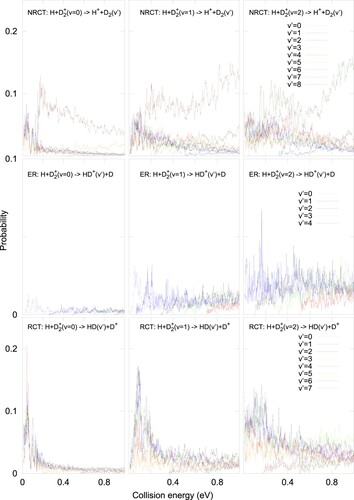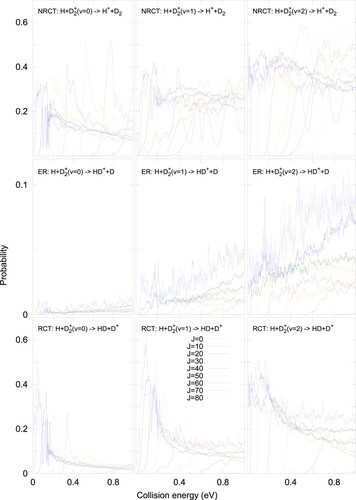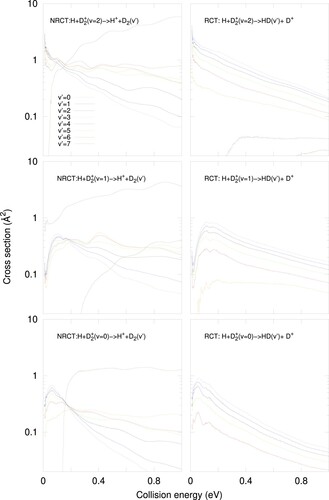Figures & data

Figure 1. Features of the 3 x 3 PES's describing the H+D
H
+ D
charge transfer process, where r is the D
internuclear distance and R is the distance between H and the centre-of-mass of D
. (a) Potential of D
and D
at very long distance of H atom, showing the vibrational levels on each. The energies of D
(v) are 2.056, 2.251 and 2.439 eV, for v = 0, 1 and 2, respectively. The energies of D
(v') are 1.902, 2.202, 2.487 and 2.758 for v' = 5,6, 7 and 8, respectively. (b) Adiabatic potential energies of the first 2 singlet electronic states as a function of R, for
and at a T-shaped configuration. The diabatic coupling between the two diabatic energies are also shown.

Figure 2. Vibrationally resolved reaction probability for J = 0 H+D(v = 0,j = 0) (left panels), H+D
(v = 1,j = 0) (middle panels), and H +D
(v = 2,j=0) (right panels), towards the inelastic charge transfer, NRCT (H
+D
, in the top panels), the exchange reactive channel, ER (H+HD
, in the middle panels) and reactive charge transfer, RCT, channels (D
+HD, in the bottom panels).

Figure 3. Reaction probability for different J values in H+D(v=0) (left panels), H+D
(v = 1) (middle panels), and H +D
(v = 2) (right panels), towards the inelastic charge transfer, NRCT (H
+D
), in the top panels, the exchange reactive channel, ER (H+HD
), in the middle panels and the reactive charge transfer, RCT, channels (D
+HD), in the bottom panels.

Figure 4. Reaction cross section for H+D(v = 0, 1 and 2) towards the inelastic charge transfer, NRCT (H
+D
, in the top panel), the exchange reactive channel, ER (H+HD
, in the middle panel) and the reactive charge transfer, RCT, channels (D
+HD, in the bottom panel). The experimental values are taken from Ref.[Citation5,Citation6].
![Figure 4. Reaction cross section for H+D2+(v = 0, 1 and 2) towards the inelastic charge transfer, NRCT (H++D2, in the top panel), the exchange reactive channel, ER (H+HD+, in the middle panel) and the reactive charge transfer, RCT, channels (D+ +HD, in the bottom panel). The experimental values are taken from Ref.[Citation5,Citation6].](/cms/asset/2720a8e7-6164-480a-a4c6-d73b7f1b1564/tmph_a_1948125_f0004_oc.jpg)
Figure 5. Vibrationally resolved state-to-state cross section for H+D(v=0, 1 and 2) towards the inelastic charge transfer, NRCT (H
+D
(v'), in the left panels), and the reactive charge transfer, RCT, channels (D
+HD(v'), in the right panels).

Figure 6. NRCT probabilities obtained in collisions at several J values using the ‘exact’ wave packet results (WP) and the approximated time independent close coupling (TICC) results, as described in the text.

Figure 7. NRCT cross section obtained in H + D(v = 2) collisions comparing the total NRCT ‘exact’ wave packet results (WP), the state-to-state wave packet cross section for D
(v' = 7), and the approximated time independent close coupling (TICC) results. The experimental values are taken from Ref.[Citation5,Citation6].
![Figure 7. NRCT cross section obtained in H + D2+(v = 2) collisions comparing the total NRCT ‘exact’ wave packet results (WP), the state-to-state wave packet cross section for D2(v' = 7), and the approximated time independent close coupling (TICC) results. The experimental values are taken from Ref.[Citation5,Citation6].](/cms/asset/d37618ca-1ea3-465b-81a4-0d53e4929398/tmph_a_1948125_f0007_oc.jpg)
